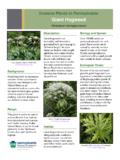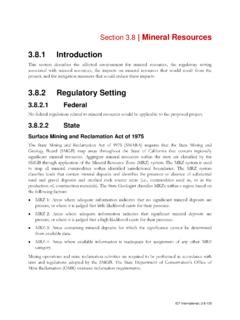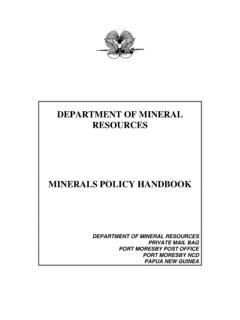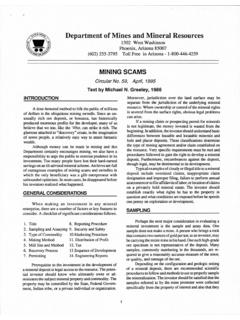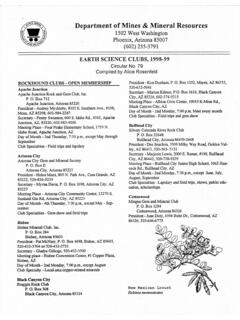Transcription of The Nonfuel Mineral Resources of Pennsylvania
1 Educational Series 12. The Nonfuel Mineral Resources of Pennsylvania COMMONWEALTH OF Pennsylvania . department OF CONSERVATION AND NATURAL Resources . OFFICE OF CONSERVATION AND ENGINEERING SERVICES. BUREAU OF TOPOGRAPHIC AND GEOLOGIC SURVEY. COMMONWEALTH OF Pennsylvania . Edward G. Rendell, Governor department OF. CONSERVATION AND NATURAL Resources . Michael DiBerardinis, Secretary OFFICE OF CONSERVATION AND ENGINEERING SERVICES. Larry G. Williamson, Deputy Secretary BUREAU OF TOPOGRAPHIC AND GEOLOGIC SURVEY. Jay B. Parrish, Director FRONT COVER: The top photograph shows a sand and gravel operation known as Mt. Cydonia No. 2, operated in the eastern part of Franklin County in the early 1980s. The bottom photograph shows the same operation about 10 years later, following reclamation of the land to form a pond and golf course.
2 Photographs courtesy of Randy Van Scyoc, Val- ley Quarries, Inc. Educational Series 12. The Nonfuel Mineral Resources of Pennsylvania by John H. Barnes and Robert C. Smith, II. Pennsylvania GEOLOGICAL SURVEY. FOURTH SERIES. HARRISBURG. 2001. When reproducing material from this booklet, please cite the source as follows: Barnes, J. H., and Smith, R. C., II, 2001, The Nonfuel Mineral re- sources of Pennsylvania : Pennsylvania Geological Survey, 4th ser., Educational Series 12, 38 p. Pennsylvania web site: department of Conservation and Natural Resources web site: Bureau of Topographic and Geologic Survey web site: Illustrations drafted by James H. Dolimpio First Edition, June 2001. Fourth Printing, Slightly Revised, June 2006. ACKNOWLEDGMENTS. The authors wish to thank the following for their participation on the advisory committee that guided the initiation of this project: Margaret S.
3 Burton, Capital Area Math/Science Alliance; Greg Eckert, The Nature Conservancy; G. Robert Ganis and David (Duff) Gold, consulting geologists; Tom Holleran, Aggregates Mining and Min- erals, Inc.; Johnny Johnsson, Arundel Corporation; Kurt Leitholf, Conservation and Natural Resources Advisory Council; Kim Myers, Pennsy Supply; Randy Newcomer, Rohrer's Quarry; Helen Olena, Director of Environmental Education, department of Environmental Protection; Lane Schultz, Sheridan Construction Group; Evan Shus- ter, Bureau of Mining and Reclamation, department of Environmental Protection;. Andrew A. Sicree, Curator, Earth and Mineral Sciences Museum, The Pennsylvania State University; and Randy Van Scyoc, Valley Quarries. This booklet has been improved by thoughtful reviews by the following com- mittee members: Bob Ganis, Johnny Johnsson, Helen Olena, Lane Schultz, Evan Shuster, and Randy Van Scyoc.
4 It has been further improved by the work of addi- tional reviewers: Kurt Carr, Chief, Division of Archaeology and Protection, Pennsyl- vania Historical and Museum Commission; Joan Clippinger, Coordinator, Education and Information, department of Conservation and Natural Resources ; Donald T. Hoff, retired curator of Earth Sciences, Pennsylvania Historical and Museum Com- mission; Dave Hopkins, Baker Refractories; E. Willard Miller, Professor of Geogra- phy, The Pennsylvania State University; and Arthur A. Socolow, consulting geolo- gist and retired director of the Bureau of Topographic and Geologic Survey. Addi- tional review was provided by Samuel W. Berkheiser, Jr., Chief, Geologic Resources Division, Bureau of Topographic and Geologic Survey.
5 Ii The Nonfuel Mineral Resources of Pennsylvania ne day, several million years ago, a very early ancestor of ours whose O identity is lost forever picked up a rock and used it to do something. Whether the rock was used to crack open a nut, frighten away a preda- tor, or was simply a toy to play with, this was the start of our dependence on Mineral products. With time, our ancestors were shaping rocks into better tools. By million years ago, prehuman toolmakers in east Africa realized that some rocks were better for making sharp-edged tools than other rocks. After many millennia of evolution and learning, the knowledge of how to sepa- rate the chemicals that make up rocks was unlocked. This allowed the use of rock products to manufacture other products.
6 Centuries later, this knowledge helped to give rise to the industrial revolution and our modern way of life. At the dawn of the twenty-first century, we live in an information age dominated by the excitement of powerful new technologies. We refer to the long-ago era of stone tools and spear points as the Stone Age. But our need for stone is as great now as ever. New uses are constantly found for the raw materials that come only from the earth. Everything that we need to build the most advanced computer comes from the earth and has been avail- able since prehistoric times! Today we use knowledge accumulated over cen- turies to combine raw materials in new and exciting ways. Tomorrow, raw materials from the earth will be combined in ways that we cannot even imag- ine.
7 Despite all of our advances, we are at least as dependent on nature's raw materials as any cave dweller ever was. According to the Geological Survey, $ billion worth of Nonfuel minerals was mined in Pennsylvania in 2003. We will explore the past, pres- ent, and future impact of that production. At the end of the booklet is a list of books that have additional infor- mation. We also rec- ommend reading Edu- cational Series book- lets 3, 7, and 8 to learn about Pennsylvania 's groundwater, coal, and oil and gas Resources . For an introduction to geological concepts discussed in this booklet and an overview of the events that, over billions of years, formed Pennsylvania 's Mineral Resources , we recommend Educational Series booklet 4, The Geological Story of Pennsylvania .
8 1. 2 THE Nonfuel Mineral Resources OF Pennsylvania . WHAT ARE Mineral Resources ? Mineral Resources are naturally occurring materials that are found in the ground and are used in our daily lives. When the Resources are extracted from the ground they are referred to as Mineral products. Most of the items that we deal with in life are made from Mineral products. These include nearly everything you might think of, including television sets, refrigerators, stoves, computers, autos, planes, and trains. Even our homes contain min- eral materials in the bricks, tiles, window panes, roofing, cement, wiring, pipes, linoleum, and insulation. Although plant and animal products, such as wood, wool, and cotton, are not minerals, they are processed and manu- factured by machinery made of metals and are fastened by nails, buttons, or zippers.
9 All rocks are made up of minerals, but only Mineral occurrences for which there is a market and commercial use qualify as Mineral Resources . To be extracted (or mined), a Mineral resource has to have a high enough quality and quantity to cover the cost of mining and processing. Pennsylvania is for- tunate to have a considerable number of minable Resources whose annual total value makes this state a leading Mineral producer. The word Mineral , like many words, has more than one meaning. To a person who works with Mineral products and re- sources, Mineral includes rocks, sand, gravel, and even coal and petroleum. This is different than the definition used by scientists who study a branch of geology called mineralogy. To a mineralogist, a Mineral is a naturally occurring, inorganic substance that has a specific composition and crystal form.
10 Minerals are the building blocks that make up rocks. Some minerals that are commonly found in Pennsylvania include the silicon- based minerals quartz, feldspar, mica, and pyroxene;. and the carbonate minerals calcite (calcium carbon- ate) and dolomite (calcium magnesium carbonate). Rocks that are considered to be Mineral Resources in- clude two carbonate rocks, limestone, which consists mostly of calcite, and dolomite, which consists mostly of the Mineral dolomite; diabase, which consists mainly of interlocking laths of feldspar and pyroxene (a mi- croscopic view is shown to the right); and sandstone, which commonly con- tains quartz and feldspar. WHAT ARE Mineral Resources ? At the end of the twentieth century, approximately 700 active quarries and mines dotted the landscape of 64 of Penn- sylvania's 67 counties.




